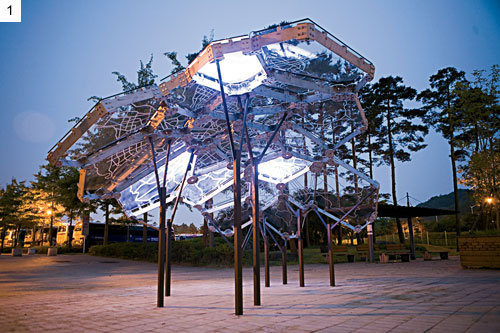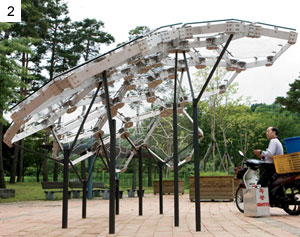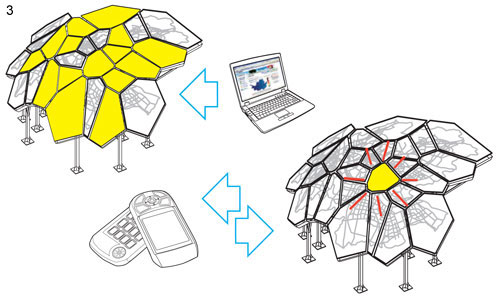Control Freaks
One of Keith Evan Green's research interests is the Animated Work Environment, or AWE, a system that suggests a way forward for the kinds of technologies Herman Miller is pursuing. Green directs Clemson University's Intelligent Materials and Systems group, in South Carolina, a collaboration between the school of architecture and programs in electrical, computer, and materials engineering. Instead of static furnishings, he envisions a desk of dynamic panels embedded with screens and contact sensors supporting control mechanisms to respond to your whims based on movement and control. A chair laden with pressure sensors could detect slouching and adjust your desk panels as needed. "We don't want to create an automated work space that takes away the authority of the individual," Green says. "It's a cognitive model."
Few topics have traditionally been as dull in architecture as building controls. Recent talk of controls generally concerned the incompatibility of systems between manufacturers. BMS systems were developed on a proprietary basis and rarely "talked" to one another, let alone to marginal control systems like those for lighting, security, and access. Without belaboring the mind-numbing details of how this technology has developed incrementally, this situation has quite recently changed. Building Automation Controls networks, or BACnet, is the standard around which most of the industry has converged toward a common digital infrastructure, or backbone, that reduces each control point, sensor, or device to an IP address. As the books by MIT's Mitchell suggest, buildings are Web sites, and vice versa. A compelling vision for new buildings, perhaps, but most existing buildings are often saddled with undermaintained proprietary systems. Volker Hartkopf, the director of the Center for Building Performance and Diagnostics at Pittsburgh's Carnegie Mellon University, argues these legacy systems may be our biggest challenge. "Unless we come up with robust systems that can be deployed again and again," Hartkopf says, likening buildings to automobiles, "we won't make any progress." Even many of the new Web-based systems have closed programming logics that will make expandability and adaptability difficult in the future. Regardless, some architects have forged ahead with the building-as-Web-site concept, finding innovative ways to make the new controls part of a comprehensive data-visualization strategy.
 |
|
 |
1., 2. Every 15 minutes, the Living Light pavilion's LED lighting system goes dark and regenerates patterns based on Seoul's air quality. 3. Living Light's control system depends on two external digital inputs - a Web site that tracks air quality and SMS text messages from people accessing the site. Photos: © The Living |
 |
|
Â
New York-based architects David Benjamin and Soo-in Yang use controls and wireless sensors in most of their projects. "The standards and protocols for ownership, storage, and transfer of data are going to be established soon, with or without architects," Benjamin says. "It's important for us to know a little bit about it." The architects direct the Living Architecture Lab at Columbia University and run a design practice called The Living. For their Living Light project in Seoul, South Korea, they created a translucent acrylic canopy based on a map of the city's neighborhoods and illuminated with strips of LEDs along the edges. The canopy's lighting-control system connects to a server that is fed data from the Web site of the city's air-quality monitoring system, collecting real-time data against the previous day's data. If air quality improves, the corresponding neighborhood panel lights up. When pedestrians request an SMS text from the Web site for the air quality of a particular neighborhood, the lights on the corresponding panel blink. In effect, Benjamin and Yang created an architectural surface layered with interactive meaning.
Visualizing the data generated by sensing and control systems, another hallmark of the new controls, is fast becoming a cottage industry in the sustainable-design realm. "Connecting everything to a common network, exchanging and transmitting data is worthless unless you can translate it into information you can act upon," says Terry Hoffmann, director of building-automation-systems marketing at Johnson Controls. Hoffmann thinks applications - what we do with this information - is the next logical challenge for industry to tackle. A seemingly limitless number of companies, including many start-ups and unlikely players like Google, have rushed into the building-dashboard arena, offering Web-based interfaces for building-management systems. The standard offering reports real-time energy consumption and that dubious holy grail, carbon footprint reduction, but some include water consumption, lighting levels, or humidity.









